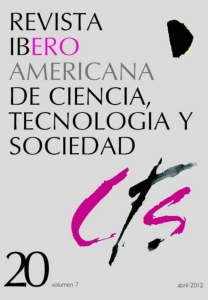Dimensions of social research on nanobiotechnology
DOI:
https://doi.org/10.52712/issn.1850-0013-685Keywords:
nanobiotechnology, social research, ethics, politicsAbstract
Nanobiotechnology can be envisaged as a set of technologies that apply nanotechnological tools, components and processes to biological systems. These applications focus on human beings in the field of nanomedicine. In parallel, nanobiotechnology is also the use of biological systems as inspiration and, literally, as scaffolding or components for the development of new nanoscale products, including new materials and nanobiosensors. The convergence of biotechnology with nanotechnology represents a process of great scientific, technological and social significance, given the capacity of this nano-bio combination to transform reality. Numerous social and environmental impacts are anticipated, from small incremental improvements in already established technologies (such as filters, sensors, materials for prostheses, medicines, etc.) to innovations today unimaginable. All this justifies the relevance of social research on nanobiotechnologies, both from a theoretical and a practical perspective. This article describes the main dimensions of such research, with anumber of issues grouped under the following labels: analysis and risk management, awareness and public understanding, technology transfer, bioethics and biopolitics, and sustainability.
Downloads
References
ACH, J. S. y WEIDEMANN, C. (eds.) (2009): Size Matters: Ethical, Legal and Social Aspects of Nanobiotechnology and NanoMedicine, Münster, Lit.
AGAMBEN, G. (2003): Homo sacer, Valencia, Pre-Textos.
AGAMBEN, G. (2004): Estado de excepción. Homo sacer II,Valencia, Pre-Textos.
BAYA LAFFITE, N. y JOLY, P. B. (2008): “Nanotechnology and Society: Where do we stand in the ladder of citizen participation?”, Cipast Newsletter, marzo.
BRUCE, D. M. (2006): ‘’Nano-2-Life ethics: a scoping paper on ethical and social issues in nanobiotechnology’’, en J. S. Ach y L. Siep (eds.): Nano-Bio-Ethics: Ethical Dimensions of Nanobiotechnology, Münster, Lit, pp 63-84.
CALLON, M., LASCOUMES, P. y BARTHE, Y. (2001) : Agir dans un monde incertain. Essai sur la démocratie technique, París, Seuil.
CASADO, M. (coordinadora) (2010): Bioética y nanotecnología, Pamplona, Civitas Thomson Reuters.
COMISIÓN EUROPEA (2010): Communicating Nanotechnology. Why, to whom, saying what and how? An action-packed roadmap towards a brand new dialogue, disponible en cordis.europa.eu/nanotechnology/src/publication_events.htm, consultado el 24 de febrero de 2012.
DE CÓZAR, J. M. (2011): Nanotecnología, salud y bioética. Entre la esperanza y el riesgo, Asturias, Sociedad Internacional de Bioética,en www.sibi.org/jgp/libros/Libro% 20Premio%20JGPA%20SIBI%202010.pdf, consultado el 24 de febrero de 2012.
DE CÓZAR, J. M. (2004): “Nano y biotecnologías: un encuentro perturbador”, Inguruak. Revista vasca de sociología y ciencia política, Monográfico: biotecnologización de lo social, 40, diciembre, pp. 159-186.
DE CÓZAR, J. M. (2009): “Aspectos sociales de las nanotecnologías”, en A. Ibarra (ed.): ¿Qué es la nanotecnología? Avances, expectativas y riesgos, Donostia, Cátedra Sánchez Mazas, colección poliedro, pp. 95-137.
DE CÓZAR, J. M. (2010): “Sobre la mejora humana por medio de las tecnologías convergentes”, Mundo Nano. Revista interdisciplinaria en nanociencias y nanotecnología, vol. 3, nº 2, julio-diciembre, pp. 49-63, en www.mundonano.unam.mx/, consultado el 24 de febrero de 2012.
DEWEY, J. (1954) [1927]: The Public and its Problems, Athens, OH, Swallow Press/Ohio University Press.
ESPOSITO, R. (2006): Bios: biopolítica y filosofía,Buenos Aires, Amorrortu.
FEENBERG, A. (1999): Questioning Technology, Nueva York, Oxford University Press.
FERNÁNDEZ AGIS, D. (2011): Bioética y biopolítica. Reflexiones sobre ética, ciencia ypolítica en el mundo actual, Saarbrücken, EAE.
GUSTON, D. y SAREWITZ, D. (2002): “Real-time technology assessment”, Technology in Society 24, pp. 93-109.
KERA, D. (2007): “Biopolitics, microbiopolitics, neuropolitics, comsmopolitics and other posthumanist views of the global society”, Masaryk University Journal of Law and Technology,135.
JOTTERAND, F. (ed.) (2008): Emerging Conceptual, Ethical and Policy Issues in Bionanotechnology,Nueva York, Springer.
LATOUR, B. (2004): Politics of Nature: How to bring the Sciences into Democracy, Cambridge, Harvard University.
LATOUR, B. (2011): “Politics of nature: East and West perspectives”, Ethics & Global Politics, 4(1), pp. 71-80.
LECHUGA, L. (2009): “Nanobiotecnología y salud: nuevos avances diagnósticos y terapeúticos”, en A. Ibarra (ed.): Qué es la Nanotecnología? avances, expectativas y riesgos,Donostia, Cátedra Sánchez-Mazas, Colección Poliedro.
MACLURCAN, D. y RADYWYL, N. (eds.) (2011): Nanotechnology and Global Sustainability,Boca Raton, CRC Press.
MALSCH, I. y HVIDTFELT-NIELSEN, K. (2010): Nanobioethics, ObservatoryNano 2nd Annual Report on Ethical and Societal Aspects of Nanotechnology, en www.observatorynano.eu/project/document/2673/, consultado el 24 de febrero de 2012.
MENDIOLA, I. (ed.) (2009): Rastros y rostros de la biopolítica,Barcelona, Anthropos.
NANOBIO-RAISE (2007):Ethical and Societal Issues in Nanobiotechnology, Nanobio- raise organization,Delft, en nanobio-raise.org/groups/editors/menus/resources/50/ view, consultado el 24 de febrero de 2012.
NANOBIO-RAISE (2008): Public Perceptions and Communication about Nanobiotechnology,Deflt, en nanobio-raise.org/groups/editors/menus/resources/50/ view, consultado el 24 de febrero de 2012.
NANOMED ROUNDTABLE (2010): Nanomed Round Table Final Report. AReport on the Nanomedicine Environment, Bruselas, en www.nanomedroundtable.org/, consultado el 24 de febrero de 2012.
OSTIGUY, C., ROBERGE, B., WOODS, C. y SOUCY, B. (2010): IRSST (REPORT R- 656) - Engineered Nanoparticles: Current Knowledge about Occupational Health and Safety Risks and Prevention Measures, segunda edición, Montreal, IRSST - Communications Division.
RIECHMANN, J. (ed.) (2009): Nanomundos, multiconflictos. Una aproximación a las nanotecnologías, Barcelona, Icaria.
RIP, Arie (2008): “Nanoscience and Nanotechnologies: Bridging Gaps Through Constructive Technology Assessment”, en G. Hirsch Hadorn et al. (eds.):Handbook of Transdisciplinary Research,Nueva York, Springer, pp. 145-157.
SHOSEYOV, O. y LEVY, I. (eds.) (2008): NanoBioTechnology: bioinspired devices and materials of the future,Totowa, Nueva Jersey, Humana Press.
STENGERS, I. (2003): Cosmopolitiques,vol. 2, París, La Découverte.
Downloads
Published
How to Cite
Issue
Section
License
Copyright (c) 2024 CC Attribution 4.0

This work is licensed under a Creative Commons Attribution 4.0 International License.
All CTS's issues and academic articles are under a CC-BY license.
Since 2007, CTS has provided open and free access to all its contents, including the complete archive of its quarterly edition and the different products presented in its electronic platform. This decision is based on the belief that offering free access to published materials helps to build a greater and better exchange of knowledge.
In turn, for the quarterly edition, CTS allows institutional and thematic repositories, as well as personal web pages, to self-archive articles in their post-print or editorial version, immediately after the publication of the final version of each issue and under the condition that a link to the original source will be incorporated into the self-archive.











